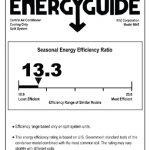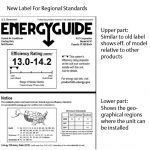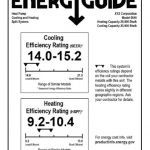What is an Energy Guide Label?
This is the yellow energy guide label prominently displayed on a new appliance. It shows the energy consumed by the device, as well as a comparison of the equipment’s efficiency to similar equipment in the market. The label is designed to help consumers make more informed buying decisions. The label will soon have a new look on air conditioners and heat pump condensing units. FTC published the ruling for the new label guidelines, which will go into effect along with the new minimum energy efficiency standards in January of 2015.
Why the change?
You may be aware of the change in Minimum Efficiency Standards for air conditioners and heat pump condensing units, to be effective in January 2015. If not, you might want to read, our recent article, “Answers to Common Questions About 2015 Regional HVAC Efficiency Standards” by clicking on the following link.
Heat pumps will now have one national standard, while air conditioners will have different standards for each of three regions: North, South and Southwest. Since the efficiency of a system is dependent on the combination of the outdoor and indoor units, it is possible that an outdoor unit may have certain indoor unit combinations that will make it compliant in one region, but not in another. In the past, this did not matter, but the new regional nature of the regulations might cause issues for manufacturers, distributors and contractors.
If there were no changes made to the current AC labels, manufacturers would have to obsolete 13 SEER models in the South and Southwest regions. And if manufacturers wanted to sell the unit as 14 SEER in the South, they would have to re-certify the same models to accommodate the different SEER requirements of each region. For example, the unit would have to be certified to meet 14 SEER regulations for the South and then recertified again to meet the 14 SEER and 12.2 EER regulations for the Southwest (which would require new model numbers). The new FTC label will be changed to avoid confusion and unnecessary work in cases like this. It will make installation of the same outdoor unit in different regions possible since the new labels will have energy calculations based on different indoor combinations and system efficiencies.
What exactly is changing?
The updated upper portion will now include a ‘range’ of the product’s efficiency rating, rather than a single number. There will also be text added to the label stating that installed efficiency depends on the installed coil. Further, the new label will include the efficiency range of similar products sold in the market. This feature will be similar to the comparisons displayed on the current label.
The lower portion of the label will contain information to help installers and consumers ensure that installed equipment complies with the Department of Energy’s (DOE) regional standards. It will provide additional content on regional standards, including a list of states where the model can legally be installed. A U.S. map illustrating regional standards information will appear on labels for products that do not meet standards in one or more regions. There will also be a link to the DOE’s database of certified equipment to allow installers and consumers to determine the ratings of specific condenser-coil combinations (https://www.productinfo.energy.gov).
What are the implications to the contractor?
Even though there will be a grace period for selling equipment manufactured before January 1, 2015, all of the equipment manufactured after that date will feature the new label. All equipment installed after June 30, 2016, must be in compliance with the new regulations, and it is important that all contractors and HVAC technicians become familiar with the new labels and methods of determining compliance. Since the system efficiency is dependent on the components installed, the contractor is going to play a crucial role in the implementation of the new standards. Be sure to take a proactive stance on understanding the 2015 regulations and continue to reference AC & Heating Connect to stay up-to-date on the details of the regulations and how they might affect you and your business.





